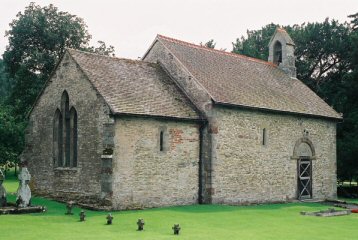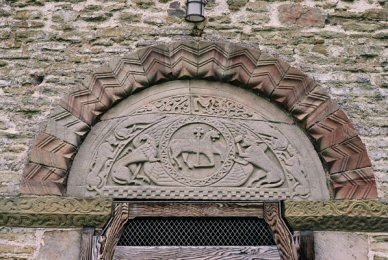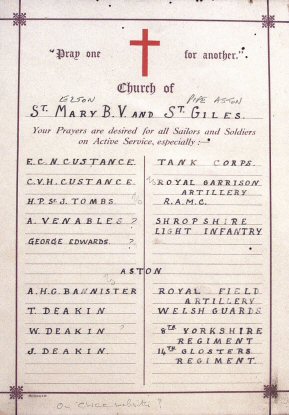
Photo : David Parker
Pipe
Aston
Herefordshire
About four miles south-west of Ludlow, in the pastoral Herefordshire countryside is the hamlet of Aston. Aston is a common name (Old English east tun or village), so to distinguish this one from the others, the civil parish is called Pipe Aston. The name originates in the clay pipes which were made here from about 1630 for about two hundred years. There are the remains of many kilns which are being excavated.

Photo : David Parker
In the village is the small Norman church of St. Giles. Apart from some minor rebuilding in the thirteenth century, it is largely unaltered. The nave has the original Norman wall paintings; the font appears to be the inverted capital of a column with a complex carving of a single dragon chasing its tail.

Photo : David Parker
The striking feature outside is the carved tympanum over the north doorway. This has a carving of an Agnus Dei or Paschal Lamb - a lamb inside a halo holding a cross - with, in Arthur Mee's words, "the eagle of St. John and the winged ox of St. Luke on either side, and a border with a bird among foliage, slithering beasts, and curious dragons." Just north of the church is the earthwork of a motte and bailey fort - Aston Tump. The moat still has some water in it.
The 1911 Census for the civil parish of Pipe Aston shows a total of 31 persons in 7 families; 17 of these were males of all ages. Inside the church is a framed Roll of Service for the Second World War. The Roll of Honour for the Great War is located in the Parish Church of St. Mary the Blessed Virgin at Elton. It is in a glazed wooden frame .This Roll of Honour names the men from Elton and from Aston in two separate lists. Four men are named from Aston, three having the same surname. Our search of our usual sources indicates that no men from Aston died in the Great War.
The Leintwardine History Group under its chairman John Williams has published a small book - a study of the 75 servicemen from the ecclesiastical parish of Wigmore Abbey who lost their lives in the two World Wars. Wigmore Abbey Parish covers nine civil parishes including Elton and Pipe Aston. The booklet is called "They Shall Grow Not Old"; it appeared in 2004 on the 90th anniversary of 1914. In a private letter, John Williams told me that "none of those listed in our booklet came from Pipe Aston". This confirms our findings. We are confident that Pipe Aston is a Thankful Village.
The situation of Elton is not so simple. When the place-name "Elton" was entered in the CD-ROM Soldiers Died, it gave the entry "16780 Acting L/Cpl Alexander Archibald Barnett, 6th Battalion King's Shropshire Light Infantry, killed in action 20.09.17 born Ludlow, enlisted Shrewsbury, resident Elton near Ludlow." The Elton Roll of Honour does not list any soldier named Barnett. On page 5 of the booklet it says that he is named on the War Memorial in Leintwardine Cemetery and on the Memorial Board in the Church of St. Mary Magdalene, Leintwardine (as is his older brother Pte William Barnett k.i.a. 31.07.17). L/Cpl Alexander Barnett has no known grave and is named on the Tyne Cot Memorial to the Missing, in Belgium.
The local newspaper, The Leintwardine Leader, of the 6th of October 1917 reports the deaths in action of Alexander and of William, sons of Mr George Barnet of Watling Street, Leintwardine. On the same page, under the heading "LEINTWARDINE D.C.M.", it reports that L/Cpl Alexander Barnet was "awarded the D.C.M. for his bravery in using a machine gun against the Prussian Guards under heavy fire after his leader had been killed on August 16th 1917". The report goes on to say "No doubt Leintwardine people will be pleased to hear of this honour which has been conferred on him". We conclude he was not a resident of Elton, and that the CD-ROM Soldiers Died is in error. (The newspaper spells the name with one 't'.)
 |
On the Elton Roll of Honour is the name "George Edwards". This is in
a different hand from all the other entries, and unlike the others gives
no regimental details. On page 9 of the booklet is named 5188 Private George
Edwards, 1st King's Shropshire Light Infantry, died 18.09.16, husband of
Agnes Edwards of 1 St. John's Road, Ludlow. In the CD-ROM, the place of birth,
enlistment and residence of 5188 Pte George Edwards are all stated to be
Ludlow. Elton is not mentioned. The name George Edwards is on the Great War
Memorial inside the porch of St. Lawrence's Church, Ludlow, but there are
no regimental details or service number.
From the available evidence, we cannot deduce if the George Edwards named at Elton is the same as the one named at Ludlow, or if he is one of the other 130 soldiers of that name who died in the Great War, or if he in fact survived. Until we have some more certain information, Elton must be placed in our List 2. |
Our thanks go to Rosalind Willatts for drawing our attention to Pipe Aston, to David Parker who has visited Pipe Aston and Elton several times on our behalf, and for his excellent photography, and to John Williams who has been a willing helper and a supplier of answers to our many questions.